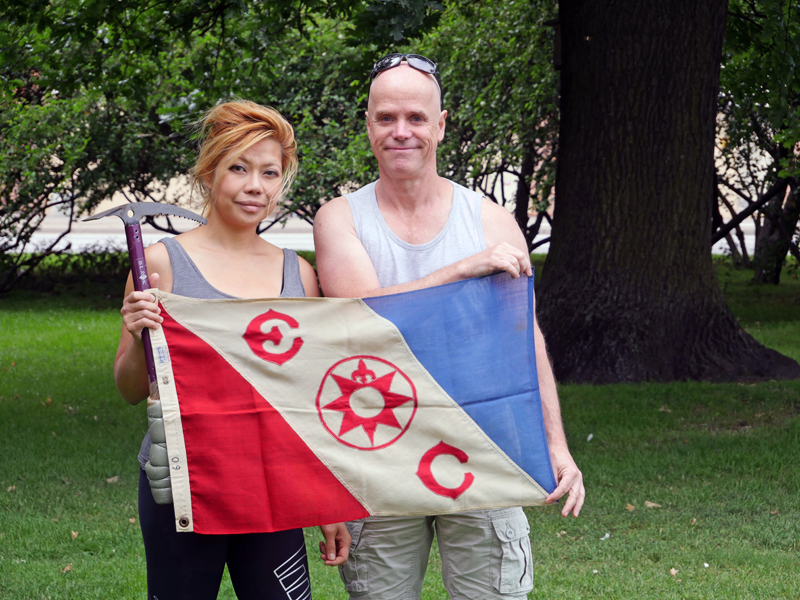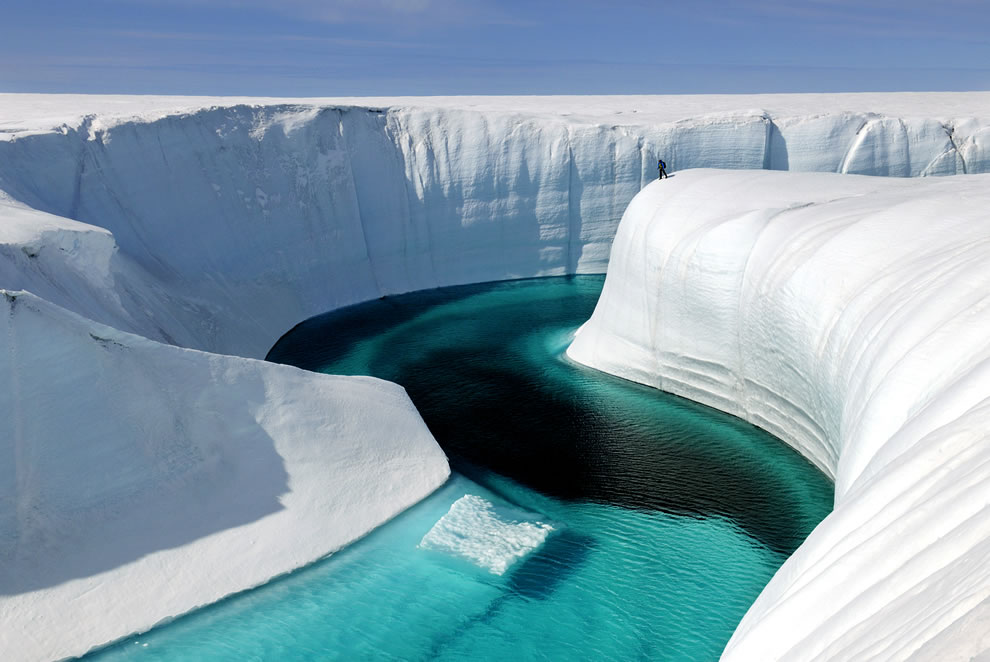Greenlandic Local Intuitive Climate Knowledge
Exploration of the Arctic dates western exploration back several thousand years, and has influenced how we imagine the Arctic. Accounts of Erik the Red, Robert and Josephine Diebitsch Peary, Knud Rasmussen, Fridtjof Nansen, E.A. Nordenskiörd, Fridtjof Nansen, and others have explored the polar regions, Greenland in particular. For many centuries, Greenland was described as ‘unexplored’, ‘mysterious’ and ‘desolated’. Above all, peoples of the north were inextricably involved in Arctic exploration. Yet, the portrayal of Inuit peoples at that time was reductive, additionally, Inuit knowledge was secondary to the science of the expedition. As we are aware of explorers’ legacy rooted in the ideas of western polar exploration, what continues to influence and validate scientific activities should not echo past exploration, and only be through the activities underpinned by national sovereignty. Accordingly, consistent with the spirit of exploration, there is a need to broaden Arctic knowledge and widen the imaginaries of western exploration.
Today, attention has been placed on Greenland’s melting inland ice as a source to the rising sea levels contributing to global environmental change GEC. Although we may agree global warming effects our lives, the benefits or virtues of preventing climate change may not be justified by the costs or future risks involved. While Greenland is a place where climate change is happening, it would be a misstep to think the environment is valued for the same reasons as it may be globally. We may be concerned for our own lives, or we might also be concerned for the lives of others living in other parts of the globe, or those not yet born. Some of us have concern for the natural world. The tumultuous sound of calving icebergs tumbling into the sea may be regarded as a risk of coastal flooding beyond Greenland, or a potential investment of bottled glacial water. Certainly, there is some reason to resist ideological views of nature and even regret the disappearance of sea ice, but that reason may be from one particular perspective entangled within the discourse of modern science. Within the climate science discourse, portrayals of Greenland’s icy landscape are of rapid climate change from frequent and stronger windstorms, changes in weather patterns, rising sea temperatures, thawing of permafrost, calving of icebergs, and the melting ice cap. Considered a source to the rising sea levels, Greenland’s melting ice cap is a sign of the anthropogenic global environmental change, GEC. True, climate change is a reality, however representations of Greenland seem un-balanced with alarm over polar bears’ survival on one end and on the other end the isolation of people surrounded by a desolate but awe-inspiring environment. It is rather, Greenlanders are effected by climate changes and profoundly have an intricate and social relational aspect to their surrounding icy landscape that is always moving, forming and changing.
Documenting climate change locally advances field science and knowledge of the Arctic environment in which to further explore other ways that show how local Greenlanders value their environment. In exploring the ways how the environment is of value, this allows for a study within how we account and document the Arctic’s icy landscape, for instance how hunters use their intuition in his/her environment. In documenting, how hunters use their intuition is to explore how hunters value their environment such as noting the reliability of the snow cover and accounting for the reasons why it is reliable. In other words, this expedition accounts by describing the purpose or reasons for ‘first hand knowing’ or intuition, and secondly, documents the ‘reliability’ of passage or journey of the hunt. Subsequently, this expedition advances field science by being in place of climate changes; capturing and observing the ‘intuitiveness’ of those living in the extremes of their environment.
With the ice cap covering ninety percent, Greenlanders living along the coast have an intricate connection to both land and sea. Living close to the sea is invariably a multisensory experience. It is as much auditory and olfactory as it is haptic and optical. After spending the last five months in Greenland, the Greenlandic Inuit we’ve spoken to do not disentangle their sensory modalities while being there hunting. Living close to the sea is to know the climate. Hunters talk of intuition. Yet, climate changes are happening in ways that the hunters are utilizing their sensory modalities less instinctively now as they did before, for instance how the wind is shifting the snow to know where to traverse.
An example from an Inuit hunter noted that sometime before, a snow-covered crevasse was a reliable passage over the ice cap because the snow stayed in place. However, in hesitation, mentioned that the northern winds are so aggressive today he no longer knows (intuitively) where the snow is going. Such that, it is not the case that there was/is less snow, rather the direction of the snow is a matter of consistency, known to develop intuition, and when the winds are changing, the climate changes; the snow moves, the ice breaks, and the skies glow longer. With these changes happening rapidly, their intuition needs to be tested for the very first time, and time again. Accordingly, this expedition explores: in what ways are changes rapidly occurring seasonally over periods, and how has the icy landscape been intuitively tested in which new routes were/are navigated in different periods of before and after that were adjusted to.
The specific observations will gather how local Greenlanders know of their environment by hearing, smelling, seeing, feeling and tasting what is in their icy landscape. Yet, it is not as simple. Questions that came up while talking to these hunters concerned: does the wind effect the shade of darkness during winter months; how can an Arctic animal’s physiology give signs of climate (e.g. hare droppings); what can be known when the ground is touched; what can be captured in the changing light and glow of darkness; how is the wind heard as it blows; when is there a smell of air ‘unclean’ to breath: what happened to the haze that once was; when it does rain, does it smell? These research questions revolve around the experience of climate through how the icy landscape is surveyed.
In order to answer these research questions, we need to explore the difference between how we perceive the climate and how the ice on the landscape is perceived. In other words, the difference between the air and the surface landscape. Pinpointing these differences is in the certain kinds of extreme conditions such as aggressive winds. Winds can be seen as the ‘medium’ of climate. To capture climate changes is to capture the effect on the landscape, e.g. blowing snow and bergy-bits onto the icy waters. Thus, capturing in this particular way of the medium onto the landscape, climate changes can be documented visually. Thereby, the methodology is to capture the ‘medium’, whether winds, falling snow, darkness and glowing of skies, greasy ice and more, as it effects the landscape. The ethnographic approach, that we call an Extreme Ethnography is an anthropological method.
Extreme Ethnography
Ethnography, anthropologically speaking is a representation of peoples, in ways that capture part of their social and cultural aspects that relates to the ways they are and how ‘things’ come to be. Extreme ethnography is influenced by anthropological methodology for which to explore visual practices, and sensory media represented through filmic images and sound done in the extreme environments. Due to Greenland’s changing climate, we’ve come to take an extreme ethnographic view of the environment and landscape as centre points – a mind-set to perceive and live through multisensory ways of feeling, tasting, smelling, seeing, hearing the landscape and be in place, fully aware of the high-risks in the environment. In high-risk environments, our bodies and mind are closely attuned. We become aware and receptive to what is beneath our feet. We sharpen our senses.
When we sharpen our eyes onto a particular object, the object becomes the foci. On the icy surface, when we focus on the rough rock or shape of the ice, the foci become distinct yet, the things among it are less distinct, blurred, out of focus. Similar to how we focus a camera. Just bringing the camera into focus entails what we perceive. With a film camera, the icy landscape is brought into successive framings. The film camera captures the changing climate in a particular way where the before and after events can be captured. In just the same way, intuition is experienced prior to the sight of things. What we experience of climate and on landscape, is happening in our everyday lives, yet it is when we begin the journey or the hunt we identify our surroundings with more openness and attunement. Each of us will be attuned to our surroundings differently and our senses diffused widely. This being so, Greenlandic Intuitive knowledge will be indispensable.
Greenlandic Local Intuitive Climate Knowledge (GLICK)
To begin to broaden western imaginaries of the Arctic, this expedition collaborates with Greenlandic Inuit hunters in how they intuitively navigate their icy landscapes. Greenlandic Local Intuitive Knowledge can be taken as a unique, essential and relevant way to capture the climate ‘medium’ in the months of seasonality. The sea ice maximum (ice covering of Arctic seas) begins from September and ends April/May. At the start of the September, the ice begins to freeze. A Greenlandic Inuit, a hunter and his/her family will also lead us out to a place ‘where there is much to see’. Film cameras will be given to Greenlanders who show an interest in the expedition, and who we will take as our Greenlandic ‘family’. The ‘Greenlandic family’ will gradually acquire specific skills in using a camera in which to capture climate changes from their point of view, through their lens. Two film cameras will be given to them to utilize and to capture climate change, as they experience it.
Systemically, at the very onset, we will document our journey to the site, at the site for a period of change from daylight or night skies and document our journey back home. This may be 10 km or 25 km from the settlement. Thereafter, we will return every 30 days to the exact place documenting from September maximum ice to April minimum ice. April/May begins the melting of sea ice. April is also the beginning period when the inland ice is crossable. This expedition not only captures the ‘medium’ of climate though Greenlandic local intuitive knowledge, this expedition captures the traversing of the ice cap.
Crossing the Ice Cap: navigating climate changes new routes over the ice cap
Perceptions of the ice cap from the perspective a western exploration is to simply traverse the ice cap from one end to the other, and this is to only preoccupy with the ‘surface’ of the ice cap without further understanding changes in climate. The third part of this expedition is an attempt to cross the inland ice sheet with a member of our Greenlandic family testing the ‘reliability’ of passage. The months of September to April is in preparation to explore how we cross. From the April/May crossing, what we hope to document is the ‘intuition’ of traversing and testing of new routes as we cross the ice cap.
Documentary filmmaking
This expedition will be part of a documentary.


